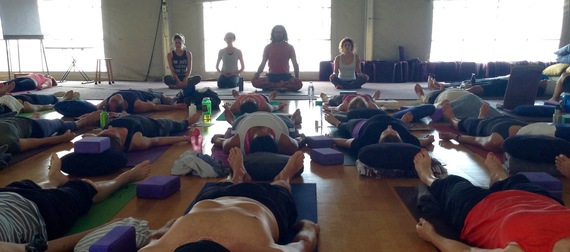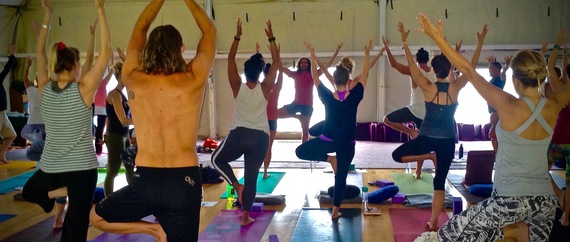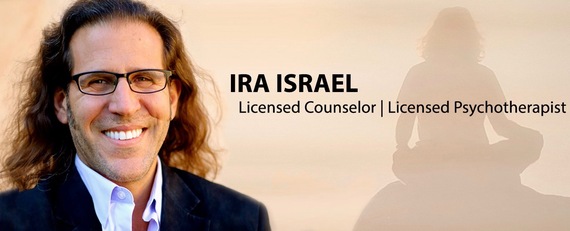Recuperating from a near-fatal automobile accident in the 1980s, I stumbled upon a film based on W. Somerset Maugham's acclaimed novel entitled "The Razor's Edge." In the film, after surviving a near-fatal incident, Bill Murray foregoes the American Dream to travel around the world seeking the meaning of life. At one point, his character, Larry Darryl, meets a coal miner who reprimands him, "You mean you've never read the Upanishads?! You don't know anything then!" This line stuck in my head during the years I lived in Paris and when I visited Asia for the first time in the early 1990s. After practicing yoga and meditation for a few years, I decided to take a Master of Arts degree in Religious Studies from UCSB so that I could study the origins of yoga and meditation in the Hindu and Buddhist religions.
Mulling over the court case in Encinitas wherein concerned parents are arguing that yoga should not be taught in the public school system because it violates the separation of church and state, I thought I would recount what I know of the history of Yoga from Vedic sacrificial fire rituals to internal breathing exercises and finally to asanas.
In Brhadaranyaka Upanisad 3.9.1, circa 500 B.C.E., breath is deified: after discussing the numerous Gods, Yajnavalkya resolves all 3306 gods down to one: "Which is the one god?" 'Breath.' Later in section 6.1.7 breath is proven to be 'most excellent' over all other body parts and functions because the body can live without speech, eyes, ears, mind, and semen, but the body cannot live without breath.
Similar to the Brhadaranyaka Upanisad, the Chandogya Upanisad also emphasizes the importance of breath. The Fifth Prapathaka again demonstrates that "Breath, verily is the chiefest and the best' among the vital functions because one cannot do without it. However, of greater importance regarding the development of yoga is the emphasis in the Chandogya Upanisad 7 on the primordial sound Om. It begins with a discussion of chants and develops the link between speech and breath, which becomes most evident in the syllable Om. The reason for this is due to the fact that both Om and breath are, in fact, Brahman. Here the primordial sound is united with the one indispensable characteristic of man, breath.
Regarding the Taittiriya Upanisad, Georg Feuerstein states that in this scripture we find the very first unequivocal occurrence of the word yoga in the technical sense, apparently standing for a sage's control of the senses.
The Kausitaki Upanisad is interesting because in section 2.1 it identifies breath (prana) with Brahma.
The Kena Upanisad is very brief but of interest because it stresses the ineffability of Brahman and also mentions tapas. Section 1.3 states,
There the eye goes not;
Speech goes not, nor the mind.
We know not, we understand not
How one would teach It.
Other, indeed, is It than the known,
And moreover above the unknown.
After discussing Brahman, section 33 of the Kena Upanisad offers some practical instruction: "Austerity (tapas), restraint (dama), and work (karman) are the foundation of it (i.e. the mystic doctrine). The Vedas are all it limbs. Truth is its abode."
The Katha Upanisad is the first Upanisad to specifically discuss yoga as a method. According to Feuerstein, the Katha Upanisad "marks the transition between the post-Vedic esotericism of the earliest Upanishads and the Pre-Classical Yoga of the Epic Age. With this work, Yoga became a recognizable tradition in its own right."
In Katha Upanisad 6.10, Yoga is summarized as follows:
When the five perceptions are stilled, together with the mind,
And not even reason bestirs itself; they call it the highest state.
When senses are firmly reined in, that is Yoga, so people think.
From distractions a man is then free, for Yoga is the coming-into-being, as well as the ceasing-to-be.
Mircia Eliade notes that the Katha is particularly important because of its emphasis on immortality, gaining liberation, freedom from death, which is only possible for a man who is able to master his senses.
The Mundaka Upanisad is interesting because in it we see the importance of tapas - or generating heat - and the sound Om for the yoga practitioner.
The Svetasvatara Upanisad discusses release from samsara through yoga, meditation, and tapas. Eliade states that "Nowhere else is the identity between mystical knowledge and immortality more frequently expressed." Section 2.8 begins the importance of controlling the mind and quieting the body's vital forces is mentioned before the rules and results of yoga are explicitly delineated for the first time:
Holding his body steady with the three (upper parts) erect
And causing the senses with the mind to enter into the heart
A wise man with the Brahma-boat should cross over
All the fear-bringing streams.
Having repressed his breathings here in the body, and having his movements checked,
One should breath through his nostrils with diminished breath,
Like a chariot yoked with vicious horses,
His mind the wise man should restrain undistractedly.
Feuerstein states that "The Shvetashvatara Upanisad recommends meditation by means of the recitation of the sacred syllable om, called the pranava. The meditative process is described as a kind of churning by which the inner fire is kindled, leading to the revelation of the Self's splendor."
The Maitri Upanisad synthesizes all of the earlier thoughts on yoga, tapas, and meditation and the six-fold yoga is outlined in section 6.18:
The precept for effecting this (unity) is this: restraint of the breath (pranayama), withdrawal of the senses (pratyahara), meditation (dhyana), concentration (dharana), contemplation (tarka), absorption (samadhi).
Please note the remarkable similarity between the sixfold Yoga of the Maitri Upanisad and Patanjali's eightfold Yoga which is comprised of restraint (yama), practice (niyama), posture (asana), restraint of breath (pranayama), withdrawal of the senses (pratyahara), concentration (dharana), meditation (dhyana), and absorption (samadhi).
The Maitri Upanisad then goes on to give even more specific yogic instructions in section 6.20:
By pressing the tip of his tongue against the palate, by restraining voice, mind, and breath, one sees Brahma through contemplation. When through self, by suppressing the mind, one sees the brilliant Self which is more subtile than the subtile, then having seen the Self through one's self, one becomes self-less.
The definition of Yoga as oneness and unity is reiterated in Maitri 6.25: Whereas one thus joins breath and the syllable Om and all the manifold world - Or perhaps they are joined!- Therefore it has been declared (smrta) to be Yoga. The oneness of the breath and mind, And likewise of the senses, And the relinquishment of all conditions of existence - This is designated as Yoga.
Although most yoga scholars cite the Bhagavad Gita as the primary text on yoga, even a scant perusal of the Principal Upanishads clearly displays the birth of yoga as a spiritual practice. People whom I greatly admire such as Larry Payne and Yoga Alliance President Richard Karpel claim that Krishnamacharaya unbridled the physical asana practice from yoga's religious Hindu origins; however, I'm uncertain that the scholars with whom I studied at UCSB in 1998 and 1999 - including Ninian Smart, David Gordon White, Barbara Holdrege, and B. Alan Wallace - as well as other yoga scholars such as Mark Singleton and the deceased Georg Feuerstein and Mircia Eliade - would agree.
It will be interesting to see what the court in Encinitas decides. Have we respectfully separated asana practice from its Hindu origins in the Upanishads and Bhagavad Gita? And if so, then why are we still calling it Yoga?


